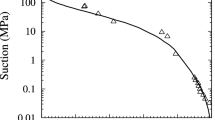Abstract
A desiccation theory is developed providing a rational framework for a three-dimensional analysis of shrinkage and crack formation in a stiff clay surface layer. With the present model, we are estimating the shrinkage stress and the chemical potential variation in a morpheme produced after cracking, in a stiff clay surface layer, in terms of measurable quantities. In regular shrinkage morphemes, the shrinkage stresses are calculated from the shrinkage displacement and moisture content change. Other parameters such as the water mobility are introduced in order to express the chemical potential and the entropy changes in terms of the moisture content change and temperature at various instants of time.
Similar content being viewed by others
Abbreviations
- A :
-
Elemental section of an area exposed by a new crack
- a :
-
Coefficient
- E :
-
Young’s modulus
- e :
-
Linear strain
- G :
-
Critical strain energy released rate
- h :
-
Interstitial fluid pressure
- h o :
-
Constant of integration
- \({J_T^a}\) :
-
Desorbed flux of water
- K(= P h /P v ):
-
Coefficient of lateral stress
- L :
-
Major diameter of a soil column formed after cracking (assumed elliptical)
- \({L_T^c}\) :
-
Wave length of maximum shrinkage
- m w :
-
Mass of water
- \({M_T^a}\) :
-
Water transportivity coefficient
- N :
-
Normal on the external surface
- P h , P v :
-
Lateral and vertical force driving shrinkage
- P ij :
-
Direct shear forces driving shrinkage
- r :
-
Internal radius of the morpheme
- Q :
-
Heat absorbed during a given change
- R :
-
Distance
- s :
-
Critical strain energy released rate
- S :
-
Entropy
- T :
-
Temperature
- ΔS i :
-
Entropy produced by the irreversible process
- ΔS e :
-
Entropy flow to or from the environment
- X ij :
-
Stress
- X′:
-
Effective stress
- X atm :
-
Atmospheric pressure
- V :
-
Volume
- U :
-
Internal energy
- w :
-
Moisture content
- W :
-
Work done
- α :
-
Coefficient
- β c :
-
Wave number of maximum shrinkage
- γ :
-
Surface tension
- λ :
-
Coefficient
- μ w :
-
Chemical potential of the soil water
- \({\xi^{p}}\) :
-
Iso-shrinkage width at the position p
- ρ :
-
Bulk density
- \({\varphi_{T}}\) :
-
Free energy at constant temperature per unit volume
- \({\Phi_{T}}\) :
-
Free energy at constant temperature
- \({\Phi_{P}=U+\Sigma x_{ij}P_{ij}}\) :
-
Total heat
References
Auriault J.L.: Nonsaturated deformable porous media: quasistatics. Transp. Porous Media 2, 45–64 (1987)
Aurianlt J.L., Lebaigue O., Bonnet G.: Dynamics of two immiscible fluids flowing through a deformable porous media. Transp. Porous Media 4, 105–128 (1989)
Bachmat Y., Bear J.: Macroscopic modelling of transport phenomena in porous media, I. The continuum approach, II Applications to mass, momentum and energy transport. Transp. in Porous Media 1, 213–269 (1986)
Brouswijk J.J.B.: Modelling of water balance, cracking and subsidence of clay soils. J. Hydrol. 97, 199–212 (1988)
Callen H.B.: Thermodynamics, An Introduction to the Physical Theories of Equilibrium Thermostatics and Irreversible Thermodynamics. Wiley, London (1959)
Dasog G.S., Acton D.F., Mermust A.R., de Jong E.: Shrink–swell potential and cracking in clay soils of Saskatchewan. Can. J. Soil Sci. 68, 251–260 (1988)
Gardner W.R., Fireman M.: Laboratory studies of evaporation from soil column in the presence of water table. Soil Sci. 85, 244–249 (1958)
Gardner W.R., Hillel D.: The relation of external evaporative conditions to the drying of soils. J. Geophys. Res. 67(110), 4319–4325 (1962)
Griffith A.A.: The phenomena of rupture and flow in solids. Philos. Trans. R. Soc. Lond. A 221, 163–198 (1962)
Haines W.B.: The volume changes associated with variations of water content in soil. J. Agric. Sci. 13, 296–310 (1923)
Karalis T.K.: On the elastic deformation of non-saturated swelling soils. Acta Mechanica 84, 19–45 (1990)
Karalis T.K.: Compressibilité des argiles gonflantes non saturées a partir des essais rhéologiques. Can. Geothech. J. 67, 90–104 (1990)
Karalis T.K.: Quelques résultats théoriques et expérimentales concernant le gonflement anisotrope. Journal de Physique 2 1(7), 717–738 (1991)
Karalis T.K.: Water flow in non-saturated swelling soil. Int. J. Eng. Sci. 5, 751–774 (1993)
Karalis T.K.: Thermodynamics of phase transitions in swelling/shrinking surficial soil layers. Mater. Sci. Eng./A 175, 247–264 (1994)
Karalis T.K.: Mechanical behaviour of a non saturated soil swelling non hydrostatically. Appl. Mech. Rev. 48(10), 623–643 (1995)
Karalis T.K.: On the optimization of shrinkage in soft cohesive soils. Acta Mechanica 171, 119–131 (2004)
Kowalski S.J., Strumillo Cz.: Moisture transport, thermodynamics, and boundary conditions in porous materials in presence of mechanical stresses. Chem. Eng. Sci. 52(7), 1141–1150 (1997)
Murad M.A., Bennethum L.S., Cushman J.H.: A multi-scale theory of swelling porous media: I. Application to one-dimensional consolidation. Transp. in Porous Media 19, 93–122 (1995)
Mainguy M., Ulm F.-J.: Coupled diffusion-dissolution around a fracture channel: the solute congestion phenomenon. Transp. Porous Media 80, 481–497 (2001)
Raats, P.A.C.: Mechanics of cracking soils. In: Bouma, J., Raats, P.A.C. (eds.) Proceedings ISSS Symposium on Water and Solute Movement in Heavy Clay Soils. International Institute for land Reclamation and Improvement, Wageningen, The Netherlands, pp. 23–38 (1984)
Sridharan A., Rao G.V.: Mechanisms controlling volume change of saturated clays and the role of the effective stress concept. Geotechnique 23(3), 359–382 (1973)
Tempany H.A.: The shrinkage of soils. J. Agric. Sc. 8, 312–333 (1917)
Terada K., Ito T., Kikuchi N.: Characterization of the mechanical behaviours of solid–fluid mixture by the homogenization method. Comput. Methods Appl. Mech. Eng. 153, 223–257 (1998)
Author information
Authors and Affiliations
Corresponding author
Rights and permissions
About this article
Cite this article
Karalis, T.K., Karalis, K.T. A model for regular desiccation cracks formation. Acta Mech 223, 1517–1536 (2012). https://doi.org/10.1007/s00707-012-0672-6
Received:
Revised:
Published:
Issue Date:
DOI: https://doi.org/10.1007/s00707-012-0672-6




